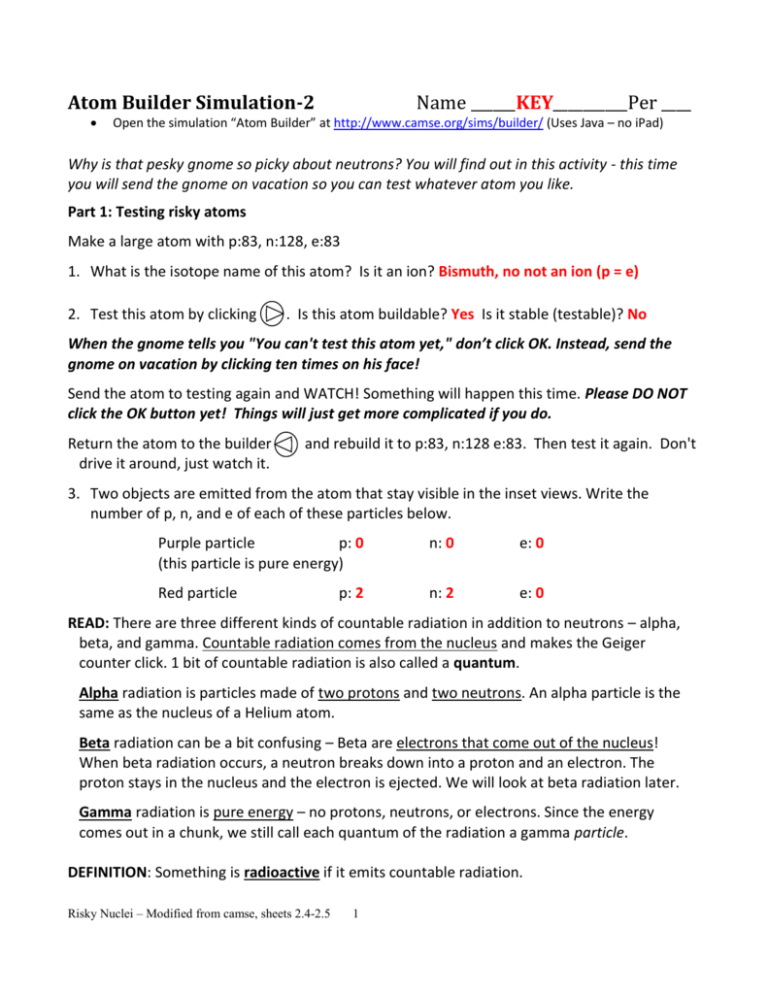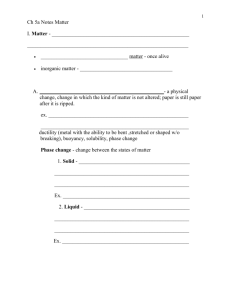Make a large atom with p:95, n:146, e:95 - TSDCurriculum
advertisement

Atom Builder Simulation-2 Name ______KEY__________Per ____ Open the simulation “Atom Builder” at http://www.camse.org/sims/builder/ (Uses Java – no iPad) Why is that pesky gnome so picky about neutrons? You will find out in this activity - this time you will send the gnome on vacation so you can test whatever atom you like. Part 1: Testing risky atoms Make a large atom with p:83, n:128, e:83 1. What is the isotope name of this atom? Is it an ion? Bismuth, no not an ion (p = e) 2. Test this atom by clicking . Is this atom buildable? Yes Is it stable (testable)? No When the gnome tells you "You can't test this atom yet," don’t click OK. Instead, send the gnome on vacation by clicking ten times on his face! Send the atom to testing again and WATCH! Something will happen this time. Please DO NOT click the OK button yet! Things will just get more complicated if you do. Return the atom to the builder drive it around, just watch it. and rebuild it to p:83, n:128 e:83. Then test it again. Don't 3. Two objects are emitted from the atom that stay visible in the inset views. Write the number of p, n, and e of each of these particles below. Purple particle p: 0 (this particle is pure energy) n: 0 e: 0 Red particle n: 2 e: 0 p: 2 READ: There are three different kinds of countable radiation in addition to neutrons – alpha, beta, and gamma. Countable radiation comes from the nucleus and makes the Geiger counter click. 1 bit of countable radiation is also called a quantum. Alpha radiation is particles made of two protons and two neutrons. An alpha particle is the same as the nucleus of a Helium atom. Beta radiation can be a bit confusing – Beta are electrons that come out of the nucleus! When beta radiation occurs, a neutron breaks down into a proton and an electron. The proton stays in the nucleus and the electron is ejected. We will look at beta radiation later. Gamma radiation is pure energy – no protons, neutrons, or electrons. Since the energy comes out in a chunk, we still call each quantum of the radiation a gamma particle. DEFINITION: Something is radioactive if it emits countable radiation. Risky Nuclei – Modified from camse, sheets 2.4-2.5 1 4. Write: After reading about alpha, beta, and gamma radiation, what is the scientific name of each particle that was emitted from Bi-211? Purple particle’s name: gamma Red particle’s name: alpha 5. DEFINITION: Something is radioactive if it emits countable radiation. Two students were talking about the things shooting out of the atoms in the simulation. Rob said: I agree that some of the quanta we see in the inset windows are countable radiation. But an atom can’t be radioactive because it would emit lots of radiation for a long time. An atom just spits out a few particles and then it's done. It is not like our radioactive objects. Maria replied: But if countable radiation is coming from atoms, then the atoms must be radioactive in order for the definition of "radioactive" to make sense! Do you agree more with Rob or with Maria at this point? Explain. Maria. Atoms emit the particles (countable radiation) so the atoms are radioactive. Read: Think about how many atoms are in each radioactive object we saw at the start of class. A 55 gram bolt has about 6 x 1023 iron atoms in it. The small black dots of iron near the pencil in the picture each have fewer iron atoms, about 6 x 1017 (600,000,000,000,000,000 ). 6. If each atom in one of our radioactive sources (from the start of class) emitted one piece of countable radiation, would that be a lot of radiation or not much? Yes, a lot of radiation. Part 2: Alpha Particles - an alpha particle is a helium nucleus made of two protons and two neutrons. Send the gnome on vacation if he isn't already gone! Read: Radon (222Rn) is often present in basements and can cause cancer. Radon is a gas, so you might breathe it in. Radon emits an alpha particle and the atom that remains is a solid, which will stay in your lungs and continue to emit radiation as it eventually decays to lead. Risky Nuclei – Modified from camse, sheets 2.4-2.5 2 Do and write: Make a radon-222 atom with p:86, n:136, e:86. Test it. 7. After it explodes just once (do not click on OK!) use the chart to write the name of the old and new atoms and the number of protons and neutrons that were ejected. Subtract the number of ejected particles from the number in the original atom. That should equal the number of remaining particles. Does it? Name of the new atom: Number of p and n in nucleus before the explosion: Number of p and n ejected from the nucleus: Number of protons 86 Subtract row 2 from row 1: Number of p and n in nucleus after the explosion: Number of neutrons 136 2 2 84 134 84 134 8. You also noticed a package of energy (a gamma particle with p:0, n:0, e:0) coming from the original radon atom. Do you suppose the radon nucleus contained that energy before it was emitted? Why or why not? Yes because the nucleus exploded. Part 3: Beta particles Now you will test smaller atoms with large numbers of neutrons. 9. Do and write: Go back to the building screen and build an atom with p:6, n:9, e:0 so there are NO electrons in the atom. Test it. Is there radiation? What comes out? 1 electron and 1 gamma 10. Think and write: Did the electron in the inset window come from the nucleus or from the electron cloud? How do you decide? (Hint: How many electrons were there to start with?) It must have come from the nucleus because there were no electrons in the electron cloud. 11. Do and write: This will help you understand what happened. a. Compare your original Carbon nucleus to the new nucleus that resulted after it exploded. What is the name of the new atom? How many p and n? Original nucleus: Carbon p: 6 New nucleus: Nitrogen p: _7_ n: _8_ Risky Nuclei – Modified from camse, sheets 2.4-2.5 3 n: 9 b. The electron that exploded out of this atom came from the nucleus! But this raises some questions: i. There wasn't an electron in the nucleus to start with. ii. The number of protons has changed - how? Went up by 1 iii. The number of neutrons has changed - how? Went down by 1 c. How can the nucleus "lose" one neutron and "gain" one proton and emit one electron, even though no neutrons or protons went in or out? (Hint: Consider the charges on the neutron, protron, and electron.) Check with your neighbors, then write the best explanation. A neutron (no charge) “broke” into a proton and an electron. (“transformed” would be a better word than broke) 12. Do and write: The electrons in the electron cloud outside of the nucleus determine whether an atom has a positive or negative charge. Do these electrons affect an atom’s radioactivity? Return to the building screen (back arrow) and make a Bismuth nucleus (p:83, n:128, e: whatever). Experiment with the number of electrons to see if a positive or negative charge affects the outcome. Write your conclusions here. Electrons in the electron cloud don’t make a difference. Summarizing Questions: I. Is it correct to say that the particles that come out of a nucleus are radioactive, or is it better to say that the atoms are radioactive? Why? The atoms are radioactive. The particles are the radiation. They have a high energy and can do damage, but something is radioactive if it emits radiation. II. Name of the three kinds of countable radiation that come out of a nucleus. Draw three pictures that show what makes up each of these particles. Alpha – 2 + and 2 n Beta – 1 e Gamma – pure energy III. A student once came up with the "Dirt Theory of Radioactivity". He said "I think radiation is like dirt - it comes from radioactive things. When radiation gets on other things they become radioactive just like dirty shoes make the floor dirty". Based on what you now know about the causes of countable radiation, does the "Dirt Theory" make sense at this point or not? Explain your answer. The particles that come out are no longer radioactive. But if you rubbed a radioactive substance on you, (like Uranium) then you would be radioactive. Risky Nuclei – Modified from camse, sheets 2.4-2.5 4








